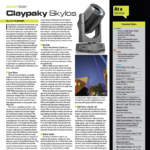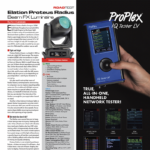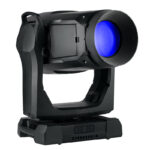Beam fixtures have certainly become commonplace in the world, but when one thinks of these we normally think of the small fixtures with a tiny aperture that project pencil-thin beams. That was then and quite frankly, this is now. The VL6000 Beam takes everyone’s preconceived notion of what a beam fixture should be able to do and has doubled down on it. This unique fixture is like no other, changes color like no other, emits lumens equivalent to a long throw spotlight and is the fastest large-yoke fixture I have ever seen. And it’s virtually silent.

The Body
The fixture arrived in a sturdy road case encased in a custom foam insert, riding on its side. We were pleasantly surprised when two of us went to take this fairly wide fixture out and found it to weigh a mere 61 pounds. Handles on the yokes and base make it a snap to flip it onto its base. The first thing immediately recognizable is the 14-inch-wide aperture on the face of the fixture. The VL6000 Beam has a retro search light appeal to it, with an ellipsoid reflector array system that Philips has an exclusive on.
The fixture appears stylish to the eye. Like many VL products, this one has a lightweight black cover that is made from form-fitted materials. The base is incredibly small for a head this size, but it is round and sturdy. The address is simple to set and the fixture utilizes 23 DMX channels. How the power supply fits in this stealth base is beyond me. The whole fixture takes up the same amount of space as a ball measuring two feet in diameter. Pan and tilt locks make it simple for one person to hang it with two clamps. The head of the fixture does get too hot to touch quickly, but the handles and base are fine. There is some minimal fan noise, but other than that, the fixture is totally silent in movement, strobing and all other functions.

The Output
The 1500-watt Philips MSR Gold Fastfit bulb is set back inside the head. It shines through the interior mechanical systems, exiting through a four-inch-wide hole in the center of the parabolic shaped reflector. It then strikes a convex sided mirror stationed in the center of the beam’s field. This mirror is held in place by a triangular formation of three rods, which adds to the retro look. The beam bounces off this mirror into the concave shaped ellipsoid reflector, which then reforms the output into a perfectly collimated 6.5° beam.
The fixture requires 200-240 volts to operate. It strikes, warms to full and homes in under a minute. The 6300° color temperature of the bulb gives us a scorching white daylight tinted beam. Make no mistake that when they say this fixture offers an output of 55,000 lumens, they aren’t kidding. With the sharp regular defaulted beam, I measure over 600 footcandles from 50 feet away. There is an evident hot spot in the center that cannot be helped, but it is minimal in comparison to fixtures that use the R- class discharge bulbs. There is a focus function that enables the user to sharpen the edge of the beam as well as take it way out of focus. The iris function can reduce the beam size to about 1°, giving that pencil beam. When I adjust the focus to the other extreme, I get a scorching white beam that increases the foot-candle measurement another 20 percent. I shine this beam on a wall 50 feet away and the diameter of the beam is 14 inches, the same as the front aperture of the fixture.
The strobe functions are divided into two channels, one for type of strobe and one for rate.
They are flawless. The dimming curve is straightforward and perfectly linear to my eye — a welcome improvement over most beam fixtures on the market. There is a frost lens located in the beam path, which is not variable. It softens the edge of the beam while expanding its width just slightly. The frost knocks the light’s output down 30 percent, which is minimal for this application.
There is a gobo wheel with seven rotating, indexable gobos, some of which VL users will recognize. I am able to get them fairly sharp with the focus function. The gobos are all nice aerial breakups. There is no zoom function in this fixture so textured style gobos aren’t warranted. The beam looks quite good rotating in a smoke filled room, and looks cool as well when run out-of-focus.

The Color System
This system took me a few minutes to work my head around how it works, then I fell in love with the setup. There are three wheels of six fixed dichroic colors in close slots, no continuous gradations of typical CYM flags. This keeps the fixture emitting maximum lumens. The wheels themselves are actually labeled as cyan, magenta and yellow because each wheel of its name contains three separate gradations of color filters of those labeled colors, sandwiched between darker saturated colors. For instance, the first wheel starts with open white, followed by 100-percent magenta. A dark saturated blue color is next on the wheel, followed by a 60-percent magenta flag. From there, we have saturated pink, followed by a 30-percent magenta filter. By using this formula with all three wheels, the programmer can make up 55 distinct color combinations between mixing the dichroic filters and using them alone.

Each color wheel has its own channel as well as a separate channel for speed. The color wheels can be told to go the shortest route to the next color (snap function) or use the cue’s timing. By using your own color palettes and the way the color filters are laid out in the wheel, you will rarely pass a bright color en route to mixing your next one. The colors do snap quickly, reminiscent of the old VL models. There is a shake mode on each wheel as well that can be adjusted in speed. It shakes incredibly fast, reminding one of an LED color shift strobe effect. Each wheel can spin continuously in either direction at variable speed. I can stop the wheel instantly in place if I want.
There is a separate color channel with color macros already in place. The user can scroll through available combinations of premade colors that consist of single, mixed and split color combinations. They are numbered in a smart order per color. This saves on programming time. There is an extra channel that can be used in conjunction with these color macros. Referred to as the Cloak Transition Generator, it can be thought of as similar in concept to the “move in black” function some lights offer, but instead, this is “color changing in black” — for example, when you are using color macros and you don’t want to see the light scroll through many color combinations to get from color 5 to color 30 on a timed cue. This new function automatically blacks out the dimmer for a set period of time (while the color system switches to the desired filters), then fades back in by itself. This is a time-saver, as the programmer never has to write cues to black a fixture out, change color then fade it back in themselves to avoid flurries of colors scrolling. It’s basically a user-defined auto fade, as I can choose between one-second intervals all the way up to ten second crossfade times.

At a Glance
A Full-Featured Searchlight
I found that once again Vari-Lite has set the bar high by developing this wide aperture, yet reasonably sized beam fixture. It is indeed a searchlight. The revolutionary color system, fat collimated beam and lumens output make this a mandatory light for any arena shows’ arsenal. With an IP22 rating, it is a well-thought-out package that should be okay under marginal weather conditions. —N.S.
Vari-Lite VL6000 Beam
PROS: Lightweight with an aesthetically pleasing design. Amazing optical system, wide aperture, silent, bright collimated beam with linear dimmer curve. Unique color system for maximum output.
CONS: None
- STATS:
- Weight: 61.5 lbs.
- Size: 26 x 23.8 x 24”
- Bulb: 1500W Philips MSR Gold FastFit
- Total wattage: 2,140W
- Control: DMX, RDM, Stand Alone
- Software Uploads: Via USB port
- MSRP: $10,999
- Manufacturer: Philips Vari-Lite
- More Info: www.vari-lite.com



